
Related
Guests
- Glen MacDonaldJohn Muir memorial chair of geography, director of the White Mountain Research Center and a UCLA distinguished professor. He has studied climate change and the causes and impacts of wildfires. MacDonald and his family evacuated their Southern California home on Friday to escape the Woolsey Fire.
At least 44 people are dead and more than 200 remain missing as two massive wildfires, fueled by easterly winds and a historic drought, continue to rage in California. In Northern California’s Butte County, the Camp Fire has become the state’s deadliest fire in history, after the blaze swept through the town of Paradise, killing 42 people and destroying nearly 6,500 homes. In Southern California, a quarter-million residents of Los Angeles and Ventura counties were ordered to evacuate the Woolsey Fire—including the entire city of Malibu and parts of the San Fernando Valley. Governor Jerry Brown said Sunday that the fires were driven by climate change and that California needs to learn to adapt. We speak with climate expert Glen MacDonald, John Muir memorial chair of geography, director of the White Mountain Research Center and a UCLA distinguished professor. He was forced to evacuate his Thousand Oaks home due to the Woolsey Fire.
Transcript
JUAN GONZÁLEZ: In California, at least 44 people are dead and more than 200 remain missing as two massive wildfires, fueled by easterly winds and an historic drought, continue to rage. In Northern California’s Butte County, the Camp Fire has become the state’s deadliest fire in history, after the blaze swept through the town of Paradise, killing 42 people and destroying 7,200 structures—nearly 6,500 of them are homes. Recovery workers say some victims were reduced to bone fragments, raising the prospect of a much larger death toll, as some 228 people remain missing.
In Southern California, a quarter-million residents of Los Angeles and Ventura counties were ordered to evacuate the Woolsey Fire, including the entire city of Malibu and parts of the San Fernando Valley. The fire, which has killed at least two people, tore through oceanside homes as panicked residents sought to escape through a massive traffic jam along the Pacific Coast Highway. The Woolsey Fire began near the Santa Susana Field Laboratory, site of a partial nuclear meltdown nearly 60 years ago. California’s Department of Toxic Substances Control said it did not believe the flames kicked up any radioactive materials. On Sunday, Governor Jerry Brown said the fires were driven by climate change and that California needs to learn to adapt.
GOV. JERRY BROWN: We’re in a new abnormal, and things—things like this will be part of our future. And this won’t be the beginning. It’ll be things like this and worse.
AMY GOODMAN: The fires are so large they can be clearly seen from space. Smoke and ash have left millions of Californians exposed to air quality rated “unhealthy” or “very unhealthy” levels, with residents of Los Angeles, Sacramento and the Bay Area warned against spending time outdoors.
President Trump responded to the fires by blaming California officials and threatening to cut off federal aid. Early Saturday, he tweeted, “There is no reason for these massive, deadly and costly forest fires in California except that forest management is so poor. Billions of dollars are given each year, with so many lives lost, all because of gross mismanagement of the forests. Remedy now, or no more Fed payments!” Trump tweeted.
It drew outrage from first responders and state officials. This is Los Angeles County Fire Department Chief Daryl Osby.
FIRE CHIEF DARYL OSBY: We’re in extreme climate change right now. We don’t control the climate. We’re doing all that we can to prevent incidents and mitigate incidents and save lives. I personally find that statement unsatisfactory, and it’s very hurtful for all first responders that are putting their lives on the line to protect lives and property.
AMY GOODMAN: Following a wave of criticism, Trump approved an expedited major disaster declaration for California Monday, unlocking federal funds and resources for those affected by the fires.
For more, we go directly to Thousand Oaks, California, where we’re joined by climate scientist Glen MacDonald, who, along with his family, had to evacuate his Southern California home on Friday to escape the Woolsey Fire. MacDonald is the John Muir memorial chair of geography, director of the White Mountain Research Center and UCLA distinguished professor.
Professor MacDonald, welcome to Democracy Now! So, you had to move out of your home. I mean, Thousand Oaks has been hit so hard, first the massacre of 12 people at the country music bar, and then, as soon as that happens, people have to clear out, have to evacuate, for this horrific fire. I’m so sorry for all you’re dealing with. But can you talk about the fire, about Trump saying it’s bad forest management, and about the governor saying this is climate change?
GLEN MacDONALD: Well, first, thank you very much for having me on the show today. It’s a pleasure to speak with you. And you’re right. It’s been traumatic for our community. My wife and I were at the vigil for the victims of the Borderline shooting. And we came home that evening, and at 11:20 we got the first call from the emergency alert system here in Ventura County telling us that we were under voluntary evacuation. We could look to the ridgeline and see it was glowing red. And I knew it was just a matter of time, so we began to pack. And, sure enough, less than an hour later, we got the call for mandatory evacuation. So, it has been a rough—a rough time here.
About the fire, you know, in some ways, this is a typical late fall, early winter fire event, with very, very high Santa Ana wind speeds, ignition at a time of year when our fuels are absolutely bone dry. And so, these sorts of fires are anticipatable. They would be anticipatable without climate change.
What climate change is doing, however, is that we see that in the—since the year 2000, we’ve had about 15 of our 20 largest recorded wildfires here in the state. So, we have good records. About 15 of those 20 have occurred since the year 2000. And that’s really been linked to and coincidental with record temperatures, increasing temperatures, that we see in this century. And those high temperatures, they do several things. Of course, they promote high evaporation rates in the summer, when we’re not getting any replenishment of water for the fuels, so the fuels become super, super dry. They prolong our fire season. They start it earlier in the spring, and they prolong it later into the autumn and into the winter. And they’re a driving force in this.
So the governor is quite correct. We could anticipate that these sort of events will occur in the future, and they will become worse. In fact, modeling, trying to look at what we’ll look like in 2100, is pretty universal in saying that, you know, our fire frequencies are going to increase, our fire sizes are going to increase. Maybe we’ll have a, at least one model suggests, 77 percent increase in fire activity like this by the time we get to the end of the century. So, these temperatures are driving things, and we can attribute those to increased greenhouse gases. But they’re not the only thing. Again, we would have these fires regardless of what’s going on with the climate. But they might not be as big. They might not be as frequent. They might not be as difficult to fight.
JUAN GONZÁLEZ: Well, Professor MacDonald, given the increased density of population, not only—well, throughout all of California, but especially Southern California, what about the issue of how people get out of harm’s way, the problems that have been shown over and over again in terms of evacuation, with highways becoming actually potential ways for more people to die, as they’re trying to escape?
GLEN MacDONALD: Right. This is—I mean, one of the issues that we see in California wildfires, this is a built environment. It’s a human environment, how we plan our communities, how we build them. You have to remember that far over 90 percent of the fires in the state are ignited by humans, by human activity. This is not all firebugs and stuff. It’s an Edison or PG&E line going down. It’s a weed-clearing machine throwing up a spark. It’s someone’s car breaking down, and they go to the side of the road, and they start a fire. So, vast majority of our fires are started by people. As we have more people in the state and we have more people living in the wildland-urban interface zone, we can anticipate that we will have more ignition sources, but we can also anticipate that more people are in harm’s way. And we’re not going to be able to not have these fires. Pretty much anywhere you build at lower elevations here in the state, you’re going to be in a fire zone. You’re going to have fuels there. The natural vegetation will burn.
So, how do you protect yourself when a fire gets going? If we take a look at the—you know, the deadliest fire that happened, that was not of fire crew-related deaths, but of civilians, you go to 1991, the Tunnel Fire in Oakland, where you had some 25 people lost their lives. A number of them lost their lives in their cars trying to flee that fire on congested roads in the hillside. The two fatalities in Malibu, my understanding is, at this point, were in a car trying to flee the fire. I am sure that many of the fatalities that we find in the Paradise region will be similar. There are roads, if you take a place like Topanga Canyon, you have one way out, each direction, very, very narrow, small roads. You know, you will never get everybody out there in time, unless you get them out well before the fire occurs. And I think that in Ventura County, the alert system to tell people to get out, in Los Angeles County, the alert system to tell people to get out, they really worked this time. If we look at the size of this fire, we look at the number of structures which were destroyed—over 700, I believe, at this point—we look at its geographic scope, you know, we—it’s terrible that we had fatalities, but we had a very, very small number of fatalities. You know, people obeyed, and our first responders were very good in helping those people that didn’t. But really, it’s early warning, but it’s also people believing that and evacuating, which is what my wife and I did.
AMY GOODMAN: The Woolsey Fire began near the Santa Susana Field Laboratory, site of a partial nuclear meltdown nearly 60 years ago. The California Department of Toxic Substances Control said it didn’t believe the flames kicked up any radioactive materials. Do you believe that?
GLEN MacDONALD: You know, again, I simply haven’t looked at any of the data from that, so I’m not going to comment one way of the other on that. I’m going to go with their scientists. And if they believe that at this point, I think that that would be where I would be. But, of course, I would want to see due diligence and, obviously, some monitoring of what was kicked up.
By the way, nuclear waste is not the only thing up in Santa Susana. You know, they disposed of a lot of rocket fuels and things like that. There are other pollutants that are up there. And there is a pretty robust monitoring program. And I think we need to see. I think we need to see how that may have exacerbated some of the issues with the Santa Susana test grounds.
JUAN GONZÁLEZ: And, Professor MacDonald, I’m wondering if you could comment on the federal response. I’m thinking—I see thousands of U.S. Army troops sent by President Trump to the border to protect—supposedly, help protect the border against a caravan of Central American refugees, but the president’s response to the California fires is basically to condemn the way that California has been handling forest management.
GLEN MacDONALD: Yeah, I think that was very, very disheartening to see the president, I think, essentially, attempting to score some cheap political points, you know, on the backs of people who are suffering here and on the backs of people, both state and federal agency people, who are really battling hard these fires and doing a tremendous job. Enough good cannot be said about the first responders here and in Northern California. And so, to get that, you know, instead of the president having our back and showing some empathy, some sympathy, or even some basic understanding of what’s going on here, was disheartening. And I think you’ve heard the responses to that from the leadership of state and local firefighting officials. I think they were dismayed by it.
And it was plumb out wrong. It really betrayed a lack of understanding. There’s no forest management that you’re going to put in place for the chaparral or coastal sage scrub vegetation that’s burning down here, or grasslands. These are not forests. They’re not trees. They’re not where thinning or salvage logging is going to do any good. My understanding from the Paradise fire is a lot of that was carried by grass understory—some of those forests have burned; they’ve been naturally thinned—that probably no prescriptive treatment would have done much up there, either. Again, I haven’t been up there, but that’s my understanding from what I’ve read. And so, you know, the president’s words were wrong. I mean, if he would maybe make a visit here and see the types of fuels and see how our communities are configured relative to those fuels, maybe he would be more enlightened. I’m not optimistic about that, but that’s where we’re at.
AMY GOODMAN: And we have 10 seconds. What do you say to President Trump about climate change, a well-known climate change denier?
GLEN MacDONALD: Well, you know, we’re going to keep paying the price, unless we start getting a handle on this and at least start having some very proactive adaptation at a federal level. And we certainly are doing it here in the state.
AMY GOODMAN: Glen MacDonald, we want to thank you so much for being with us. Be safe. John Muir memorial chair of geography, director of the White Mountain Research Center, UCLA distinguished professor, has studied climate change and the causes and impacts of wildfires, evacuated with his family there in Southern California to escape the Woolsey Fire.
You can also go to our website at democracynow.org to see our interview with incarcerated firefighters. Yes, about a quarter of the firefighters are prisoners. They make a dollar an hour fighting the fires. We visited one of their camps and spoke to them. Democracynow.org. We’ll be back in 30 seconds.

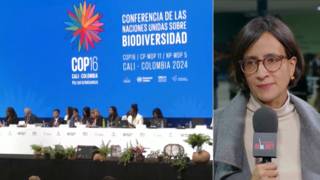
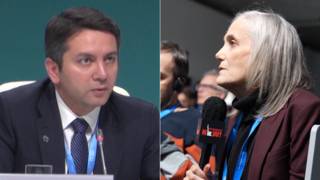
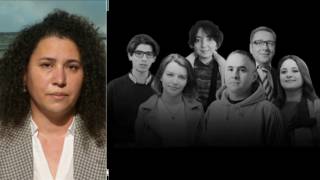
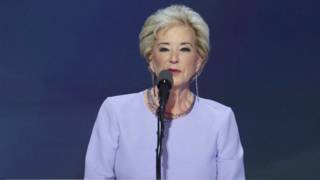





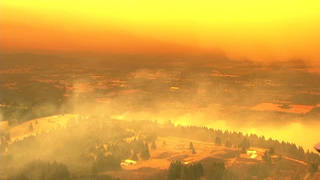
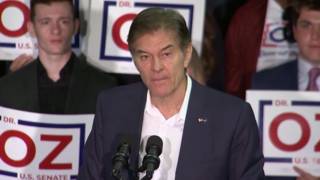
Media Options